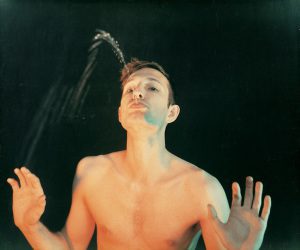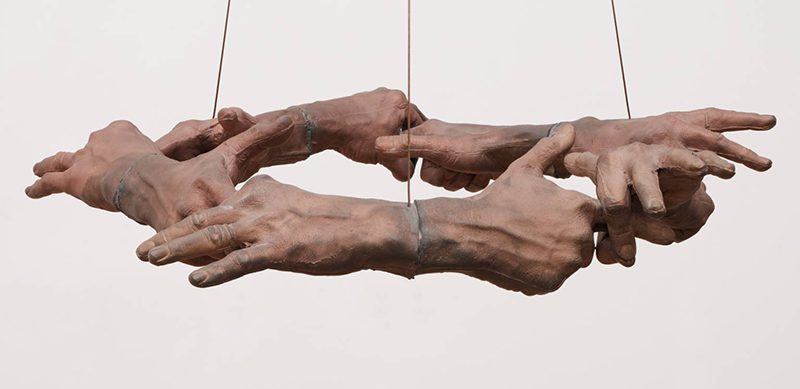TRACES: Bruce Nauman
 Today is the occasion to bear in mind the American Artist Bruce Nauman (6/12/1941- ). He remains one of the most influential Contemporary American Artists. His innovative and provocative ideas are expressed in a wide range of media and materials, which makes it difficult to categorize his work as inhabiting a single style. This column is a tribute to artists, living or dead, who have left their mark in Contemporary Art. Through documents or interviews, starting with: moments and memories, we reveal out from the past-unknown sides of big personalities, who left their indelible traces in time and history…
Today is the occasion to bear in mind the American Artist Bruce Nauman (6/12/1941- ). He remains one of the most influential Contemporary American Artists. His innovative and provocative ideas are expressed in a wide range of media and materials, which makes it difficult to categorize his work as inhabiting a single style. This column is a tribute to artists, living or dead, who have left their mark in Contemporary Art. Through documents or interviews, starting with: moments and memories, we reveal out from the past-unknown sides of big personalities, who left their indelible traces in time and history…
By Dimitris Lempesis
 Bruce Nauman was born on 6/12/41, in Fort Wayne, Indiana. His father, an engineer and a salesman, moved the family several times to different locations, resulting in a somewhat turbulent and lonely childhood for Nauman. A shy and small youth, Nauman enjoyed reading, and studied piano, guitar, and upright bass. He received no training and very little exposure to Visual Art during his childhood and did not develop a true passion for creating art until college. Nauman began his secondary education at the University of Wisconsin, where he first concentrated on math and physics, but after his sophomore year he informed his parents that he would become an artist and graduated in 1964 with a Bachelor’s Degree in science with a minor in painting. He married his first wife, Judy, in 1964. They had a son, In 1966, he graduated with an MFA from the University of California, Davis. Among his instructors at Davis were William T. Wiley, Robert Arneson, and Manuel Neri. All three worked in sculpture and outside the norms of the time, which undoubtedly had a profound influence on Nauman’s desire for non-conformity. Upon his graduation, he moved to a studio in San Francisco and taught a weekly early morning class at the Art Institute, seldom encountering his colleagues and peers. This solitary lifestyle contributed to the development of a method of working in seclusion that would persist for several years. In his very early career at Davis, Nauman made experimental paintings and “Plastic things”, mainly working in oil and producing abstract and landscape works. He also experimented with welding steel forms and affixing them onto canvas, painting three-dimensional landscape shapes. While at Davis, he decided to give up painting, claiming that the materials “Got in the way”. This break with painting spurred an exploration of media, and in subsequent years, Nauman became prolific in film, performance and sculpture. He first produced fiberglass sculptures in 1965, using casting to focus on the process of art-making itself, and entering the Process art movement by disregarding the art object itself in favor of its creation. By the fall of 1966, art making for Nauman had become not a method by which to make a finished product, but an activity that was art in itself. During late ‘60s and early ‘70s, Nauman’s work and career developed quickly. He had his first solo show in 1968 at the Leo Castelli Gallery in New York, and was also included in many prominent group shows of the time, such as “Eccentric Abstraction” in New York, Documenta 4 in Kassel, Germany, and “Anti-illusion: Procedures/Materials” at The Whitney Museum. Although rejected by many American critics for the anti-formal nature of his work, European curators, already primed for critique of formalism by artists like Joseph Beuys and the Italian Arte Povera group, embraced Nauman’s work, particularly his alternative media. This surge of interest culminated in 1972 when gallerists Jane Livingston and Marcia Tucker organized a widely touring, extensive survey of Nauman’s work for the Los Angeles County and Whitney museums. He began to employ more text in his works, channeling his anger and frustration into phrases such as “Please/Pay Attention/Please” and “Placate My Art” that were featured in the compositions. While attempting to incorporate text into his sculptures of the period, he was challenged to find a cohesive way of incorporating his voice into his commanding structures, and although he created numerous neon light works and installations, his sculpture evolved in a more conceptual direction, withholding information and requiring a complex response from the viewer by creating “uncomfortable spaces and shapes”. By the early 1980s, Nauman replaced text-driven installations and model pieces with important, aggressive neon light works and sculptures, evolving his use of language correspondingly. From the ‘80s onward, Nauman has employed a wide variety of media, incorporating language and political commentary for which he is well-known. Continuing to experiment with bizarre forms and unusual materials, his art has stayed original and captivating throughout his long career. Some of his most recent works, the 2009 sound installation pieces, Days and Giorni, were featured at the Venice Biennale of that same year, representing the United States and winning the Golden Lion award. In 1989, he married the painter Susan Rothenberg.
Bruce Nauman was born on 6/12/41, in Fort Wayne, Indiana. His father, an engineer and a salesman, moved the family several times to different locations, resulting in a somewhat turbulent and lonely childhood for Nauman. A shy and small youth, Nauman enjoyed reading, and studied piano, guitar, and upright bass. He received no training and very little exposure to Visual Art during his childhood and did not develop a true passion for creating art until college. Nauman began his secondary education at the University of Wisconsin, where he first concentrated on math and physics, but after his sophomore year he informed his parents that he would become an artist and graduated in 1964 with a Bachelor’s Degree in science with a minor in painting. He married his first wife, Judy, in 1964. They had a son, In 1966, he graduated with an MFA from the University of California, Davis. Among his instructors at Davis were William T. Wiley, Robert Arneson, and Manuel Neri. All three worked in sculpture and outside the norms of the time, which undoubtedly had a profound influence on Nauman’s desire for non-conformity. Upon his graduation, he moved to a studio in San Francisco and taught a weekly early morning class at the Art Institute, seldom encountering his colleagues and peers. This solitary lifestyle contributed to the development of a method of working in seclusion that would persist for several years. In his very early career at Davis, Nauman made experimental paintings and “Plastic things”, mainly working in oil and producing abstract and landscape works. He also experimented with welding steel forms and affixing them onto canvas, painting three-dimensional landscape shapes. While at Davis, he decided to give up painting, claiming that the materials “Got in the way”. This break with painting spurred an exploration of media, and in subsequent years, Nauman became prolific in film, performance and sculpture. He first produced fiberglass sculptures in 1965, using casting to focus on the process of art-making itself, and entering the Process art movement by disregarding the art object itself in favor of its creation. By the fall of 1966, art making for Nauman had become not a method by which to make a finished product, but an activity that was art in itself. During late ‘60s and early ‘70s, Nauman’s work and career developed quickly. He had his first solo show in 1968 at the Leo Castelli Gallery in New York, and was also included in many prominent group shows of the time, such as “Eccentric Abstraction” in New York, Documenta 4 in Kassel, Germany, and “Anti-illusion: Procedures/Materials” at The Whitney Museum. Although rejected by many American critics for the anti-formal nature of his work, European curators, already primed for critique of formalism by artists like Joseph Beuys and the Italian Arte Povera group, embraced Nauman’s work, particularly his alternative media. This surge of interest culminated in 1972 when gallerists Jane Livingston and Marcia Tucker organized a widely touring, extensive survey of Nauman’s work for the Los Angeles County and Whitney museums. He began to employ more text in his works, channeling his anger and frustration into phrases such as “Please/Pay Attention/Please” and “Placate My Art” that were featured in the compositions. While attempting to incorporate text into his sculptures of the period, he was challenged to find a cohesive way of incorporating his voice into his commanding structures, and although he created numerous neon light works and installations, his sculpture evolved in a more conceptual direction, withholding information and requiring a complex response from the viewer by creating “uncomfortable spaces and shapes”. By the early 1980s, Nauman replaced text-driven installations and model pieces with important, aggressive neon light works and sculptures, evolving his use of language correspondingly. From the ‘80s onward, Nauman has employed a wide variety of media, incorporating language and political commentary for which he is well-known. Continuing to experiment with bizarre forms and unusual materials, his art has stayed original and captivating throughout his long career. Some of his most recent works, the 2009 sound installation pieces, Days and Giorni, were featured at the Venice Biennale of that same year, representing the United States and winning the Golden Lion award. In 1989, he married the painter Susan Rothenberg.












